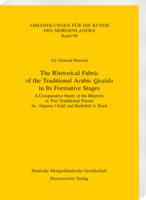|
|
more titles of the subject:
Download:
Please note: With adding digital Products to your cart
the payment will be handled via PayPal. The download will be provided after the payment is confirmed. Ali Ahmad Hussein’s book studies the rhetorical texture in two traditional tripartite poems: one from the pre-Islamic period, composed by ʿAlqama l-Faḥl, and one from the early ʿAbbāsid era, composed by Bashshār b. Burd. The poems have the same structure and deal with the same themes (love, camel-section, and praise or self praise). They also contain almost the same number of verses. A fundamental question is raised: What are the rhetorical figures on which each of the two poets depended in order to compose his poem? This, in turn, leads to a broader question: How different was the badīʿ style (“the rhetorical style”) in the poetry of the two aforementioned eras, assuming the two poems are representative of their times?
The book starts with a survey of the development of the classical rhetorical studies from the 2nd and the 8th century until modern times. The way classical and modern scholars used to analyze a literary text with reference to its rhetoric is also discussed. A clarification of some problematic issues related to the rhetorical terms used in this book follows, before the rhetoric of the two poems is analyzed in detail. The study ends with a discussion of the main thesis: What are the differences in the use of rhetoric between the two poems? |
|||||||||||||||||||||||||||||||||||||||||






